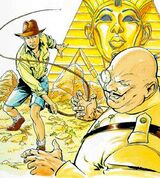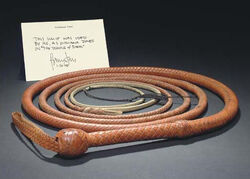No edit summary |
(List should be intergrated into article) |
||
| Line 23: | Line 23: | ||
By [[1936]] he used to take it along with his adventures. He not only used it as a weapon against animals or adversaries, but Indy had acquired enough skill to use it in several makeshift or unorthodox uses. It saved his life from several dangers, such as helping him pull levers from a distance, or as a swing rope across chasms. |
By [[1936]] he used to take it along with his adventures. He not only used it as a weapon against animals or adversaries, but Indy had acquired enough skill to use it in several makeshift or unorthodox uses. It saved his life from several dangers, such as helping him pull levers from a distance, or as a swing rope across chasms. |
||
| − | |||
| − | An interesting fact is that only once has this bullwhip been used against its owner: in the Temple of Doom by the Thuggee slave master as punishment for spitting out the Blood of Kali. |
||
| − | |||
| − | |||
| − | |||
| − | ==Known history of use== |
||
| − | |||
| − | *To dispatch an armed Barranca |
||
| − | |||
| − | *To wrap around a structure so Indy could swing across a pit |
||
| − | |||
| − | *To dispatch some thugs in Cairo |
||
| − | |||
| − | *To break a hole in the wall of the Well of Souls |
||
| − | |||
| − | *To swing across the lava pit in the Temple of Doom |
||
| − | |||
| − | *To punish Indy for spitting out the Blood of Kali |
||
| − | |||
| − | *To swing across to another platform in the mines under the temple |
||
| − | |||
| − | *To disarm a Thuggee by the rope bridge |
||
| − | |||
| − | *To swing from a gargoyle to Henry Jones's room |
||
| − | |||
| − | *To grab onto Henry's leg so that he wouldn't roll off the treads of a tank |
||
| − | |||
| − | *To swing from a light fixture in Hangar 51 in an attempt to catch up with Spalko |
||
| − | |||
| − | *To attempt to save George McHale from the UFO in Akator |
||
==Behind the scenes== |
==Behind the scenes== |
||
| Line 67: | Line 37: | ||
===Manufacture=== |
===Manufacture=== |
||
| − | Indy's whip was made with a core of twisted leather, then a plaited belly, then a bolster, then another plaited belly, then another bolster, then the final 12 plait overlay, also called "double bolster". The wrist strap is made of 6 plait overlay, and the fall is usually 30 inches long. Known substances for the cracker are nylon and poly. |
+ | Indy's whip was made with a core of twisted leather, then a plaited belly, then a bolster, then another plaited belly, then another bolster, then the final 12 plait overlay, also called "double bolster". The wrist strap is made of 6 plait overlay, and the fall is usually 30 inches long. Known substances for the cracker are nylon and poly. |
==Appearances== |
==Appearances== |
||
Revision as of 19:12, 12 August 2011
Template:Infobox Object
Indiana Jones was notable for his usage of a bullwhip, a long strip of leather.
History
When Indy was seven years old he first developed a fascination for the bullwhip, after he saw a whip-act in a traveling circus.[1] The first time Indy used a whip was in 1912 aboard the Dunn & Duffy Combined circus train while fleeing Fedora's Gang. After he accidentally fell into a wagon carrying a lion, he noticed a lion-tamer's whip and grabbed it to ward off the animal. Through his inexperience, the whip instead struck Indy below the lower lip which left his chin with a permanent scar.

Jones cuts Von Trappen.
A year later, Jones stumbled across a whip inside Tutankhamun's tomb which he used to cut Gustav von Trappen and disarm Von Trappen's guard.
Jones also employed a whip Mexico in 1916, in Demetrios' house. After the thief found Indy breaking into his cupboard of archaeological artifacts, the two struggled. Indy once again found a bullwhip there and tried to use it to fend off his attacker, before Demetrios grasped it with his iron claw and pulled it from Indy.
During World War I, Jones employed a whip for missions in London, Cairo, Bombay and Lhasa. Not only did Indy use it as a weapon but Indy first used it to climb.[2]
Sometime in 1922 Indy acquired his own bullwhip.[3] Later that year, in Delphi, he resolved to take his whip with him on every archaeological dig after he had left it behind and realised it would have been ideal in saving his life from the perilous situation he found himself while hanging over a chasm.[4] By 1925, Marion Ravenwood noticed how he practiced daily with it.
By 1936 he used to take it along with his adventures. He not only used it as a weapon against animals or adversaries, but Indy had acquired enough skill to use it in several makeshift or unorthodox uses. It saved his life from several dangers, such as helping him pull levers from a distance, or as a swing rope across chasms.
Behind the scenes
Creation
David Morgan is credited with creating the whips used in the trilogy. Over thirty whips were supplied for the films, ranging from 6 feet to 16 feet. The most commonly used whips in the films were 8 and 10 feet, with the others being used for stunts. Harrison Ford mostly carried a 10 foot whip, but used 8 foot ones for some stunts.
The whip used in the film, Raiders of the Lost Ark, was made out of kip hide, with kangaroo hide being used for the other films. At the time of Raiders, there was a problem importing kangaroo leather in to make bullwhips, so David Morgan used the leather made from young calves to make the famous whips.
Indiana Jones

Whip auctioned off at Christies in Sept. 2001
The whips were from David Morgan's 450 series, and were hand braided with a kangaroo overlay. For Indiana Jones and the Kingdom of the Crystal Skull, Terry Jacka was commissioned to create the famous bullwhips. While Jacka's were the ones cracked in the film, David Morgan and Joe Strain whips were used. Morgan's for the whip swing and Strain's for Indy's belt. Morgan's were used for the "Crate" teaser poster.
Since the creation of the films, the demand for "Indiana Jones" style bullwhips have risen. Therefore, other whipmakers have done their "interpretation" of the Morgan whip, giving those who would want an "Indy" bullwhip, a way to own one.
Manufacture
Indy's whip was made with a core of twisted leather, then a plaited belly, then a bolster, then another plaited belly, then another bolster, then the final 12 plait overlay, also called "double bolster". The wrist strap is made of 6 plait overlay, and the fall is usually 30 inches long. Known substances for the cracker are nylon and poly.
Appearances
- Indiana Jones and the Peril at Delphi
- Indiana Jones and his Desktop Adventures
- Indiana Jones and the Emperor's Tomb
- Indiana Jones and the Temple of Doom
- Raiders of the Lost Ark
- Raiders of the Lost Ark novel
- Indiana Jones and the Last Crusade
- Indiana Jones and the Kingdom of the Crystal Skull
- Indiana Jones and the Fate of Atlantis
- Indiana Jones and the Infernal Machine
